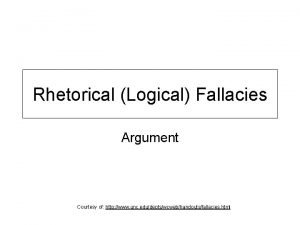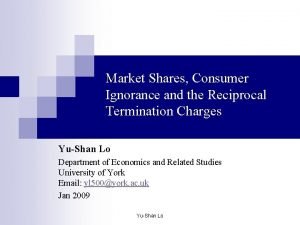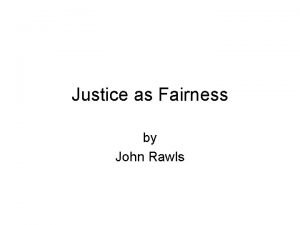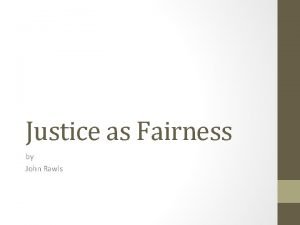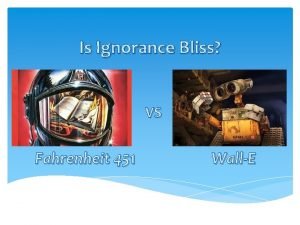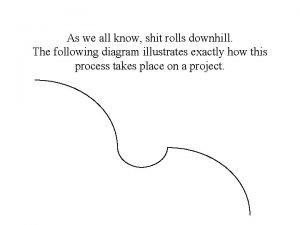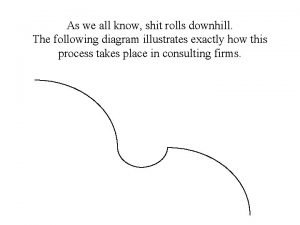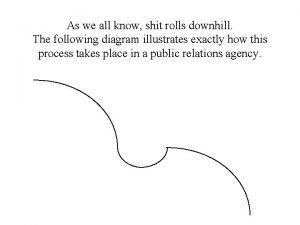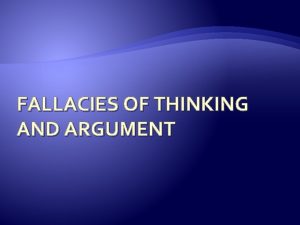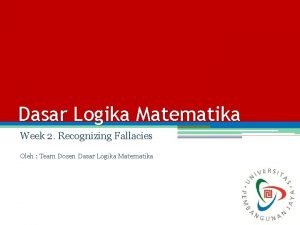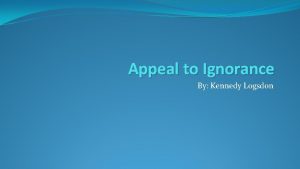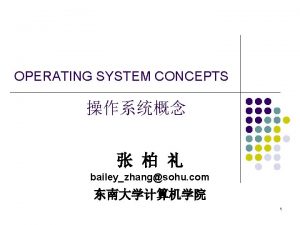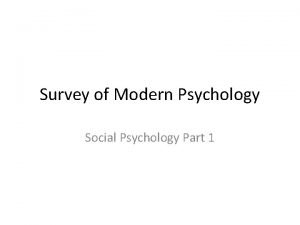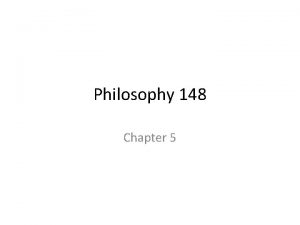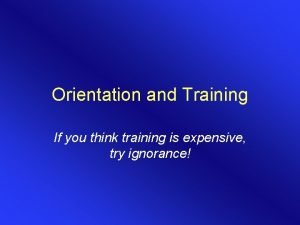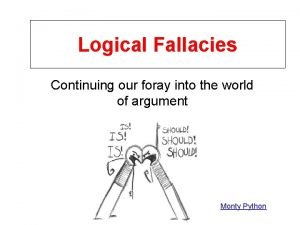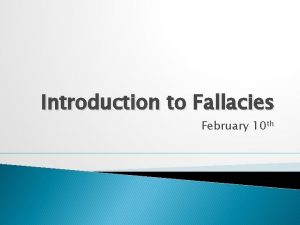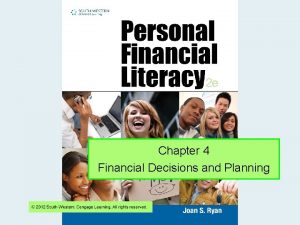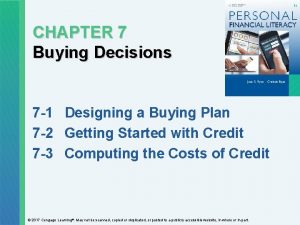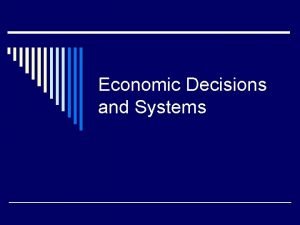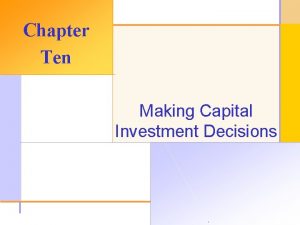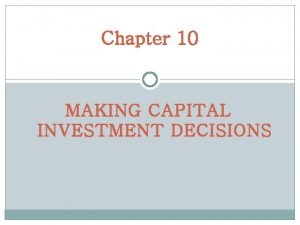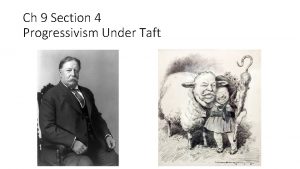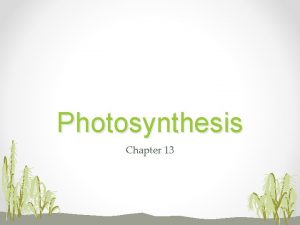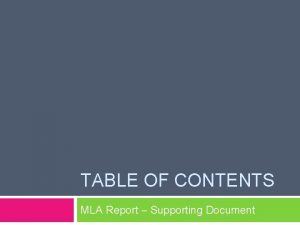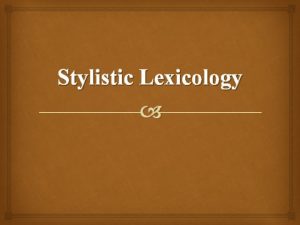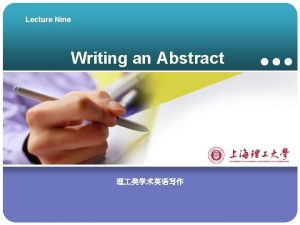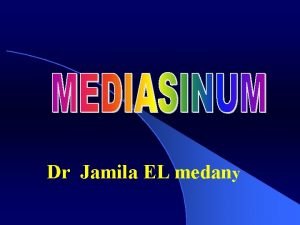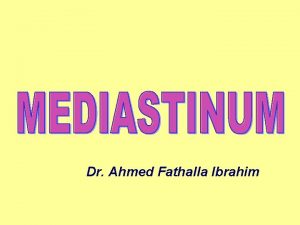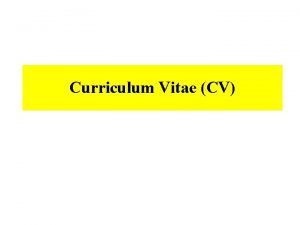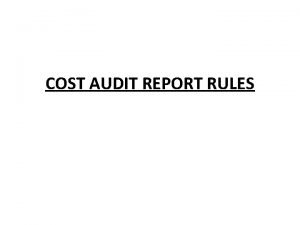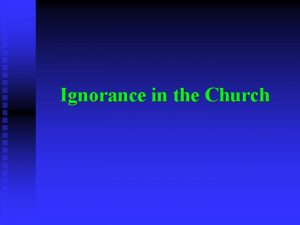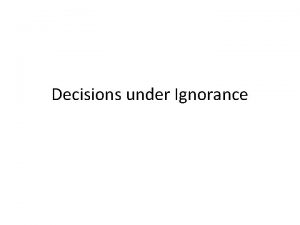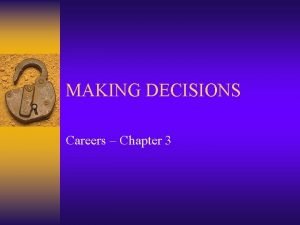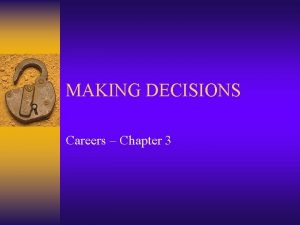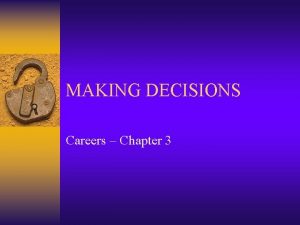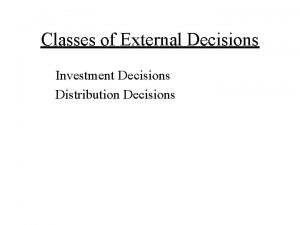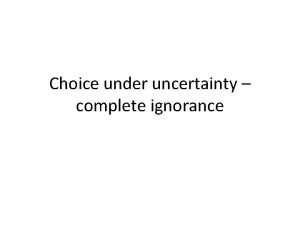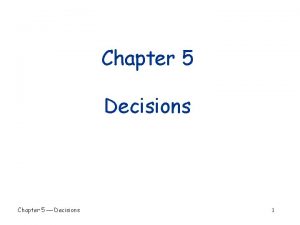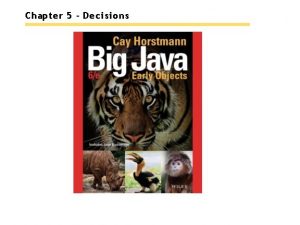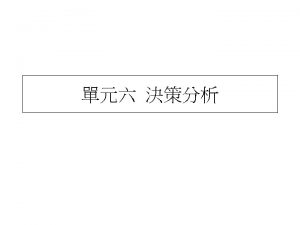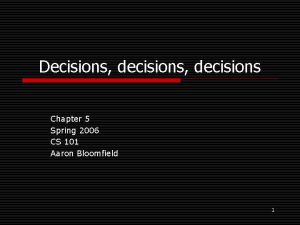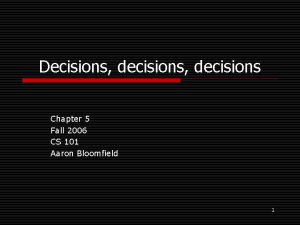Chapter 2 Decisions under Ignorance 896620423 Contents 1





























































































- Slides: 93

Chapter 2 Decisions under Ignorance 指導教授:梁德昭教授 學 生:洪智能 學 號: 896620423

Contents 1. 2. 3. 4. 5. 6. 7. 8. Preference Orderings The Maximin Rule The Minimax Regret Rule The Optimism-Pessimism Rule The Principle of Insufficient Reason Too Many Rules? An Application in Social Philosophy: Rawls vs. Harsanyi References 2

Decisions under Ignorance - KATHRYN LAMBI dilemma l KATHRYN a brilliant graduate student in physics l happily married to Paul and they want children l ought to care for her children herself during their preschool years l l dilemma l seven years from now to establish a career or to be a good mother l She believes that the latter depends on her fertility and psychic energy and that both decrease with age. 3

Kathryn’s decision l Choosing two acts: l l l have children now and postpone career pursue career now and postpone children. four states: l l In seven years K. L. will be able to be a good mother· and have a good career. In seven years K. L. will not be able to be a good mother but will be able to have a good career. In seven years K. L. will be able to be a good mother but will not be able to have a good career. In seven years K. L. will be able neither to be a good mother nor to have a good career. 4

2 -1. Preference Orderings

expression l "x. Py" l mean "the agent prefers x to y" l "x. Iy" l mean "the agent is indifferent between x and y" 6

Kathryn's decision - four states l "m & p" l l "m & -p" l l K. L. is a good mother but not a good physicist "-m & p" l l K. L. is a good mother and a good physicist K. L. is not a good mother but is a good physicist "-m & -p" l K. L. is neither a good mother nor a good physicist 7

Kathryn’s preferences l (m & p)P(m & -p), (m & p)P(-m & p) l l Kathryn prefers being both a good mother and a good physicist to being only one of the two (m & -p)I(-m & p) l she is indifferent between being a good mother while not a good physicist and being a good physicist while not a good mother? l l No, that does not follow from her wavering. In decision theory, an agent is considered to be indifferent between two alternatives only if she has considered them and is completely willing to trade one for the other. 8

ordering condition l l l l O 1. If x. Py, then not y. Px. O 2. If x. Py, then not x. Iy. O 3. If x. Iy, then not x. Py and also not y. Px. O 4. x. Py or y. Px or x. Iy, for any relevant outcomes x and y. O 5. If x. Py and y. Pz, then x. Pz. O 6. If x. Py and x. Iz, then z. Py. O 7. If x. Py and y. Iz, then x. Pz. O 8. If x. Iy and y. Iz, then x. Iz. l O 5 ~ O 8 : transitivity conditions 9

transitive preferences “trick” l Experiments can easily demonstrate that humans are not always able to have transitive preferences. l By adding small amounts of sugar to successive cups of coffee, one can set up a sequence of cups of coffee with this property: People will be indifferent between adjacent cups, but not between the first and last. This shows that sometimes we violate condition O 8. 10

transitive preferences “trick” l We fall short of that ideal by lacking tastes sufficiently refined to avoid being "tricked" into a transitivity failure. But rather than dismiss a powerful decision theory based on transitivity, we should take steps, when a decision is important, to emulate ideal agents more closely. l if some very important matter turned on a transitive ranking of the cups of coffee, we could use chemical tests to determine their relative "sweetness. " 11

indifference classes l If an agent's preferences meet conditions O 1 -O 8, items ordered by his preferences divide into classes called indifference classes. l Ten items - a, b, c, d, e, f, g, h, i and j - are as follows: l l a. Ib, a. Pc, c. Pd, d. Ie, e. If, f. Ig, d. Ph, h. Ii, i. Pj To divide into ranked indifference classes as follows: l l l a, b c d, e, f, g h, i j [5] [4] [3] [2] [1] 12

Utility – assign a number l Once we have divided a set of alternatives into ranked indifference classes, We can assign a number to each class that will reflect the relative importance or utility of items in the class to the agent. l The convention used in decision theory is to assign higher numbers to higher-ranked items. Other than that we are free to choose whatever numbers We wish. 13

The utility of x l the number assigned to an item x - called the utility of x and written “u(x)“ - be such that l l a. u(x) > u(y) if and only if x. Py b. u(x) = u(y) if and only if x. Iy for all ranked items x and y. c. w v if and only if t(w) t(v), for all w and v on the u-scale. Decision theorists call the various ways of numbering the items in a preference ordering utility functions or utility scales. l l (a), (b) are called ordinal utility functions (scales) (c) ordinal transformations 14

Ordinal scales l Ordinal scales represent only the relative ordering of the items falling within the scope of an agent's preferences; they do not furnish information about how many items fall between two items or about the intensity of an agent's preferences. 15

Dominance in terms of utilities l Define dominance in terms of utilities : An act A dominates an act B if each utility number in row A is greater than or equal to its correspondent in row B and at least one of these numbers is strictly greater. l eg. In table 2 -1, with three acts and four states, act A 2 dominates the others. 2 -1 S 2 S 3 S 4 A 1 A 2 A 3 1 2 2 0 1 -1 3 3 3 0 16

PROBLEMS Show that the following. are ordinal transformations: 4. a) b) t(x) =x - 2 t(x) = 3 x + 5 pf: (a) w v t(w) - t(v) = (w-2) – (v-2) = w-v 0 ∴ t(w) t(v) (b) w v t(w) - t(v) = (3 w+5) – (3 v+5) = 3(w-v) 0 ∴ t(w) t(v) 17

2 -2. The Maximin Rule

The Maximin Rule l Using ordinal utility functions we can formulate a very simple rule for making decisions under ignorance. l Maximin Rule l the agent to compare the minimum utilities provided by each act and choose an act whose minimum is the maximum value for all the minimums. l in brief, the rule says maximal the minimum. 19

Example - Maximin Rule l In table 2 -2 the minimums for each act are starred and the act whose minimum is maximal is double starred. 2 -2 S 1 S 2 S 3 S 4 A 1 5 A 2 -1* A 3 6 **A 4 5 0* 4 4 6 0* 3 4 4 2 7 1* 3* 20

The lexical maximin rule When there are two or more acts whose minimums are maximal, the maximin rule counts them as equally good. We can break some ties by going to the lexical maximin rule. l lexical maximin rule l l first eliminate all the rows except the tied ones and then cross out the minimum numbers and compare the next lowest entries. If the maximum of these still leaves two or more acts tied, we repeat the process until the tie is broken or the table is exhausted. 21

Example - lexical maximin rule l Applying the lexical maximin rule still leaves A 1 and A 4 tied in table 2 -3 S 1 S 2 S 3 S 4 S 5 **A 1 A 2 A 3 **A 4 0 0 0 3* 3* 3 1 0 5 2* 2* 4 4 1 3 1 1 1 3 5 22

Example l In table 2 -4 the maximin act is Al 2 -4 S 1 S 2 **A 1 $1. 50* $1. 75 A 2 $1. 00* $10, 000 23

PROBLEMS 1. Find the maximin acts for tables 2 -5 and 2 -6. Use the lexical maximin rule to break ties. 2 -5 S 1 S 2 S 3 S 4 A 1 1 -3* 5 6 **A 2 2* 2* 3 3 A 3 4 6 -10* 5 2 -6 S 1 S 2 S 3 S 4 **A 1 0 1 1 3* A 2 0 4 2* 1 **A 3 3* 0 0 1 24

2 -3. The Minimax Regret Rule

example l Examples such as the last, where the agent rejected a chance at $10, 000 to avoid a potential loss of $. 50, suggest that in some situations it may be relevant to focus on missed opportunities rather than on the worst possibilities. In table 2 -4, the agent misses an opportunity to gain an additional $9998. 25 if he chooses A 1 and S 2 turns out to be the true state, whereas he only misses an opportunity to gain an additional $. 50 if he does A 2 when the true state is Sl. 2 -4 S 1 S 2 **A 1 $1. 50* $1. 75 A 2 $1. 00* $10, 000 26

Regret l Let us call the amount of missed opportunity for an act under a state the regret for that actstate pair. Then the maximum regret for Al is $9998. 25 and that for A 2 is only $. 50. l The regret for the pairs (A 1, Sl) and (A 2, S 2) is zero, since these are the best acts to have chosen under the respective states. 27

regret numbers and regret table l We first obtain a regret number R corresponding to the utility number U in each square in the decision table by subtracting U from the maximum number in its column. l Notice that although we can use the formula R=MAX-U, where MAX is the largest entry in R’s column, the number MAX may vary from column to column, and thus R may vary even while U is fixed. MAX represents the best outcome under its state. Thus the value MAX-U represents the amount of regret for the act-state pair corresponding to R's square. 28

To obtain regret table 2 -7 Decision Table S 1 S 2 S 3 A 1 5 -2* 10 **A 2 -1* A 3 -3* A 4 0 2 -8 Regret Table S 1 S 2 S 3 A 1 0 1 10* 20 **A 2 6* 0 0 -1 5 A 3 8 0 15* -4* 1 A 4 5 3 19* 29

minimax regret rule l The minimax regret rule states that we should pick an act whose maximum regret is minimal. l To handle ties one can introduce a lexical version of the minimax regret rule. l first eliminate all the rows except the tied ones and then cross out the maximum numbers and compare the next highest entries. If the minimum of these still leaves two or more acts tied, we repeat the process until the tie is broken or the table is exhausted. 30

Example 2 -9 Decision Table 2 -10 Regret Table **A 1 3* 5 **A 1 0 2* A 2 1* 7 **A 2 2* 0 2 -12 Regret Table 2 -11 Decision Table **A 1 7* 11 A 1 0 5* A 2 3* 16 *A 2 4* 0 u’ = 2 u + 1 31

Ordinal utility transformation The minimax regret rule need not pick the same act when an ordinal utility transformation is applied to a decision table. l This means that the minimax regret rule operates on more information than is encoded in a simple ordinal utility scale. Otherwise, applying an ordinal transformation should never affect the choice yielded by the rule, since ordinal transformations preserve all the information contained on an ordinal scale. l 32

Positive linear transformation l Special case of the formula u’ = au + b , a > 0 l Suppose that (with a > 0 ) l u’(x) = au(x) + b l u’(y) = au(y) + b l l Then l l. R u’(x) u’(y) iff au(x) + b au(y) + b , a > 0 = MAX – U U a. U + b , MAX a. MAX + b ; a > 0 l R’ = (a. MAX + b) – (a. U + b) = a(MAX - U) = a. R l 33

Interval scales la >0, l l x – y z - w if and only if (ax + b) - (ay + b) (az + b) - (aw + b) This means that the distance or interval between two utility numbers is preserved under a positive linear transformation. l For this reason utility scales that admit only positive linear transformations are called interval scales 34

Summary l summarize our examination of the various decision and regret tables as follows: Although the maximin rules presuppose merely that the agent's preferences can be represented by an ordinal utility scale, the minimax regret rule presupposes that they can be represented by one that is also an interval scale. 35

disadvantage of the minimax regret rule a definite disadvantage of the minimax regret rule (In chapter 4 we will prove that if agents satisfy certain conditions over and above the ordering condition, their preferences are representable on an interval scale. ) 2) There is another feature of the minimax regret rule that disadvantages it in comparison with the maximin rules. l Tables 2 -15 and 2 -16 have been obtained by adding a new act, A 3. In the first set Al is the minimax regret act, in the second A 2 is. Thus, although A 3 is not a "better" act than A 1 or A 2 according to the rule, its very presence changes the choice between Al and A 2. Of course, the reason is that A 3 provides a new maximun utility in the first column, which in turn changes the regrets for A 1 and A 2. Yet it seems objectionable that the addition of an act (ie. , A 3), which will not be chosen anyway, is capable of changing the decision. 1) 36

Illustration disadvantage of the minimax regret rule 2 -13 Decision Table 2 -14 A 1 0* 10 4 **A 1 5 0 6* **A 2 5 2* 10 A 2 0 8* 0 2 -15 A 1 **A 2 Decision Table 0* 10 4 5 2* 10 A 3 10 5 1* Regret Table 2 -16 Regret Table A 1 10 * 0 6 **A 2 5 8* 0 A 3 0 5 9* 37

disadvantage of the minimax regret rule 2 -17 3) Decision Table Regret Table 2 -18 S 1 S 2 S 3 … S 100 A 1 0 99. 9 … 99. 9 A 2 100 0 0 … 0 S 1 S 2 S 3 … S 100 A 1 100 0 0 … 0 A 2 0 99. 9 … 99. 9 Tables 2 -17 & 2 -18. The minimax regret act is A 2. Despite, this it appears that we actually have a greater chance of suffering regret if we pick A 2, since there are ninety-nine states under Al in which we will have no regrets and only one under A 2. l It consists in pointing out that the 99 to 1 ratio of the Al zero regret to the one A 2 zero regret is no reason to conclude that states with zero regrets are more probable. 38

PROBLEMS 1. Form the regret tables and find the minimax regret acts for decision tables 2 -19 and 2 -20 2 -19 A 1 7 0 4 A 1 5 20 6 A 2 5 21 11 A 2 -3 8 10 A 3 10 -5 -1 A 3 4 5 9 39

Problem 1 - thinking 2 -19 2 -20 regret tables A 1 7 0 4 **A 1 5* 20* 6 A 2 5 21* 11* A 2 -3 8 10* **A 3 10* -5 -1 A 3 4 5 9 2 -19 decision tables 2 -20 decision tables A 1 7 3 0 21 4 7 **A 1 5 0 20 0 6 **A 2 5 5 21 0 11 0 A 2 -3 8 8 12 10 0 A 3 10 0 -5 26 -1 12 A 3 4 1 5 15 9 4 1 40

2 -4. The Optimism-Pessimism Rule

Pessimism, Optimism-Pessimism l Pessimist l l Optimism l l Maximin rule Maximax rule Optimism-Pessimism l l l compromise letting MAX be the maximum for an act and min its minimum, we want a weighting of MAX and min that yields a number somewhere in between. a. MAX + (1 - a)min, where 0 ≤ a ≤ 1 l a an optimism index 42

Example l In table 2 -21, if we let a = 1/2, the a-index for Al will be 5 and that for A 2 will be 4, and Al will be chosen. Letting a =. 2 yields a-indexes of 2 for Al and 2. 8 for A 2, and causes A 2 to be chosen. Notice that the intermediate utilities have no effect on which act is chosen. a = 1/2 A 1=1/2 × 10 + (1 -1/2) × 0 = 5 2 -21 A 1 10 4 0 A 2 6 6 2 A 2=1/2 × 6 + (1 -1/2) × 2 = 4 a =. 2 A 1=. 2 × 10 + (1 -. 2) × 0 = 2 A 2=. 2 × 6 + (1 -. 2) × 2 = 1. 2 + 1. 6 = 2. 8 43

Where do the optimism indexes come from? Each agent must choose an optimism index for each decision situation (or collection of decision situations). l The closer the optimism index is to 1, the more "optimistic" the agent is. When the index equals 1, the agent's use of the optimism-pessimism rule is equivalent to using the maximax rule. l Similarly, an agent with an index of 0 will in effect use the maximin rule. l Agents can determine just how "optimistic" they are by performing the following thought experiment. l 44

how "optimistic" They think of a decision problem under ignorance whose utility table has the form of table 2 -22, where they are indifferent between the acts Al and A 2 and where 0≤c*≤ 1. l Since the agents are indifferent between Al and A 2. and since we may assume (in this section) that they use the optimism-pessimism rule, we may conclude that the acts have identical a-indexes. Hence l l l Al =la + 0(1 -a) = c • a + c • (1 -a)=A 2 which implies that a = c*. 2 -22 A 1 A 2 0 c* 1 c* 45

no consistency on the decisions under ignorance It is to be expected that different agents will have different indexes. Furthermore, we could hardly require that an agent pick an optimism index once and for all time, since even rational people change their attitudes toward uncertainties as their living circumstances or experiences change. l Consequently, the optimism-pessimism rule imposes no consistency on the decisions under ignorance made by a group of individuals or even by a single individual over time. l 46

example 2 -23 A 1 0 A 2 2 2 -24 A 1 0 A 2 8 4 1 A 1 = 1/2 • 4 +1/2 • 0 = 2 A 2 = 1/2 • 2 +1/2 • 1 = 1. 5 10 7 A 1 = 1/2 • 10 +1/2 • 0 = 5 A 2 = 1/2 • 8 +1/2 • 7 = 7. 5 47

optimism-pessimism rule presupposes an interval utility scale 2 -23 A 1 0 A 2 2 ordinal transformation 4 1 u’ = u + 6 A 1 = 1/2 • 4 +1/2 • 0 = 2 A 2 = 1/2 • 2 +1/2 • 1 = 1. 5 2 -24 A 1 6 A 2 8 10 7 A 1 = 1/2 • 10 +1/2 • 6 = 8 A 2 = 1/2 • 8 +1/2 • 7 = 7. 5 positive linear transformations do not change the acts picked by the rule; so it presupposes no more than an interval utility scale. 48


PROBLEM 1. Find the a-indexes for all the acts presented in tables 2 -23 and 2 -24. Hint: previous expression. 2. 3. Show that in the last example the transformation of table 2 -23 into table 2 -24 is ordinal but not positive linear. Give an example of a decision table for which the optimism-pessimism rule fails to exclude a dominated act no matter what the agent's optimism index is. 50

PROBLEM Prove that if the a-index for an act A is greater than or equal to that for an act B (0≤a≤ 1), it remains so when the utilities for the acts A and B are subjected to the same positive linear transformation. (Hint: MAXA is transformed to c. MAXA + b. ) pf. a, c 0 A = a (c. MAXA + b) + (1 - a)min B = a (c. MAXB + b) + (1 - a)min A B [a (c. MAXA + b) + (1 - a)min] – [a (c. MAXB + b) + (1 - a)min] a • c (MAXA – MAXB) 0 MAXA – MAXB 0 4. 51

PROBLEM 5. Do you think that the canons of rational decision making should require more consistency among various agents than the optimism-pessimism rule requires? 52

2 -5. The Principle of Insufficient Reason

example The rules we have considered so far focus on maximums and minimums while ignoring the intermediate values and the number of states in a decision problem. l The two acts of table 2 -25 appear to be quite different, yet all the rules introduced so far in this chapter treat them as indifferent. 2 -25 A 1 10 9 9 9 9 0 A 2 10 9 0 0 0 9 l 54

equally probable and independent of our choices l In a decision problem under ignorance there is no reason for viewing one state as more probable than another. Thus, it has been argued, if we are truly ignorant, we should treat all states as equally probable and independent of our choices. 55

insufficient reason For example, suppose we are presented with a coin about which we know nothing and are asked to choose between the two bets given in table 2 -26. l Then, we should assume that no matter which bet we choose the chance of heads equals that of tails, the explanation offered being that there is insufficient reason for any other assignment of probabilities. l l we have good reasons for believing that the coin is fair 2 -26 B 1 **B 2 H -1 8 T 5 -2 Exp 2 [=1/2(-1)+1/2(5)] 3 [=1/2(8)+1/2(-2)] 56

expected utilities expected utility of an act and argue that we should maximize expected utilities. l u 1 p + u 2(1 - p) l l l where u 1 and u 2 are the outcome utilities, p is the probability of S 1 and 1 – p is the probability of S 2 expected utilities (and not average gains) are defined for choices that are made only once and they represent the agent's evaluation of an act (not just an outcome) in terms of its utility. 57

Principle of Insufficient Reason l to calculate the expected utilities for each act under the assumption that each state is equally probable and then pick an act whose expected utility is maximal. For each row this amounts to dividing the utilities by the number of states and summing the results. l We then compare the resulting sums and pick an act whose sum is maximal. l 58

shortcut l since the fractions obtained for each row have the same denominator: We simply add the entries across each row and pick an act whose resulting sum is maximal. 59

example l In table 2 -27 the expected utilities for each act (under the principle of insufficient reason) are given at the right of each row. The principle chooses A 2. 2 -27 A 1 **A 2 S 1 5 10 S 2 7 2 S 3 2 3 S 4 1 5 S 5 10 20 sum 25 40 Exp 5 8 A 3 1 4 6 4 0 15 3 60

the principle of insufficient reason must be an interval scale l Like the minimax regret and the optimismpessimism rules, the principle of insufficient reason demands that the agent's utility scale be invariant under positive linear transformations. No mere ordinal utility scale will suffice; it must be an interval scale as well. 61

Object to the principle of insufficient reason 1. if there is no reason for assigning one set of probabilities rather than another, there is no justification for assuming that the states are equiprobable either. l 2. If every probability assignment is groundless, the only rational alternative is to assign none at all. it could lead to bad results l one state with a terrible outcome or that produces a large regret has the greatest chance of being the true one. Thus the principle of insufficient reason could lead us to disaster. 62

Example - could lead us to disaster 2 -28 A 1 A 2 S 1 -100 10 l S 2 300 30 p=. 5 l l l p=. 5 **100 20 p=. 9 -60 **12 A 1=. 5 (100)+. 5 300=100 A 2=. 5 10+. 5 30=20 p=. 9 l l A 1=. 9 (-100)+. 1 300=60 A 2=. 9 10+. 1 30=12 63

PROBLEMS 1. 2. 3. Prove that the principle of insufficient reason never recommends a dominated act. Present a decision table and an ordinal transformation of it that shows that some ordinal transformations fail to preserve the acts picked by the principle of insufficient reason. Show that the shortcut version of the principle (i. e. , summing across the rows) is equivalent to the original formulation. 64

2 -6. Too Many Rules?

No, not too many rules Suppose we were to exclude the principle of insufficient reason on the grounds that we would be unjustified in a decision under ignorance in treating each state as equally probable. Would that help us determine which of the remaining rules is the correct one? No, for we have seen that strong considerations can be offered for and against each of the rules that have been proposed. l The result is that it is simply not clear which is preferable to the others. l 66

Example - contradiction The maximin, minimax regret, and optimismpessimism rules make contradictory recommendations. l In table 2 -29 maximin picks A 1, minimax regret picks A 2, and the optimism-pessimism rule picks A 3 (for an optimism index of 1/2). l 2 -29 A 1 1 14 13 A 2 -1 17 11 A 3 0 20 6 67

Example - contradiction 2 -29 A 1 A 2 A 3 1 -1 0 14 17 20 0 A 1 1 4 1 A -1 1 7 2 13 11 6 min opti ma ima mism xim x in regr pessi 6 et mism 0 12 * 31 1 1 -1 1 3 7. 5=. 2 0 7 0 5 ( 14+1) * 8=. 5 2 (17 -1) 68

Majority rule - Voting paradox 2 -30 Maximin Minimax Al vs. A 2 Al A 2 vs. A 3 A 2 Al vs. A 3 Al Al Opt. - Pess. A 2 A 3 Two out of three rank A 2 over Al, two out of three rank A 3 over A 2, and two out of three rank Al over A 3. l Thus we have a cycle: A 1 over A 3, A 3 over A 2, A 2 over A 1, A 1 over A 3, and so on. There is no first, second, or third choice, since any candidate for any position has others ranked above and below it. l 69

mixture condition If a rational agent is indifferent between two acts, the agent will be indifferent between them and the third act of flipping a fair coin and doing the first on heads and the second on tails. 1. This eliminates the optimism-pessimism rule. l l Table 2 -31 70

Example - mixture condition 2 -31 A 2 1 0 0 1 2 -32 A 1 A 2 A 3 l l Optimism index = ½ l l l A 1 = ½(1) + ½(0) = ½ A 2 = ½(1) + ½(0) = ½ A 3 = ½(½) + ½(½) = ½ 1 0 ½ 0 1 ½ Optimism index = 5/8 l l l A 1 = 5/8(1) + 3/8(0) = 5/8 A 2 = 5/8(1) + 3/8(0) = 5/8 A 3 = 5/8(½) + 3/8(½) = ½ 71

Irrelevant expansion condition l The addition of a new act, which is not regarded as better than the original ones, will not change a rational agent's ranking of the old acts. 2. The condition eliminates the minimax regret rule. l Table 2 -13, 2 -14 and 2 -15, 2 -16 72

Illustration disadvantage of the minimax regret rule 2 -13 Decision Table 2 -14 A 1 0* 10 4 **A 1 5 0 6* **A 2 5 2* 10 A 2 0 8* 0 2 -15 A 1 **A 2 Decision Table 0* 10 4 5 2* 10 A 3 10 5 1* Regret Table 2 -16 Regret Table A 1 10 * 0 6 **A 2 5 8* 0 A 3 0 5 9* 73

Re-evaluate a decision l As it turns out, the sole survivor of a seemingly reasonable set of conditions is none other than the principle of insufficient reason. Yet earlier we argued against that rule! l Reevaluate a decision 74

example l To take an illustration well known to decision theorists, suppose you sat down in an apparently seedy restaurant and were offered a choice between hamburger and roast duck. Ordinarily you prefer roast duck but you fear that this cook will ruin it. So you silently opt for the hamburger. Then the waiter returns to tells you that today you can also have frog legs sauteed in wine. The thought revolts you, but the new choice informs you that the cook has skill; so you change your mind and order the duck. 75

Example - counterargument l somebody could argue that the addition of the new act has caused such a radical change in the decision situation that the old acts are no longer options. For the old acts were order hamburger at a seedy place, order roast duck at the same seedy place. But the new acts do not include these since you no longer think of the restaurant as seedy. l Hence the restaurant example fails to call the condition into question. 76

l The debate could go back and forth over the conditions in this fashion with results no more conclusive than Our previous discussions of the rules themselves. l we will ultimately conclude that no rule is always the rational one to use but rather that different rules are appropriate to different situations. 77

PROBLEMS 1. 2. 3. 4. With respect to table 2 -32, show that A 1, A 2, and A 3 are indifferent only if the agent's optimism index is 1/2. Also with. respect to table 2 -32, show that Al and A 2 are both picked if the index is greater than 1/2 and that A 3 is picked when the index is less than 1/2. Show that the maximin rules are excluded by the condition that a rational agent always excludes dominated acts. If you had to choose one rule for making all decisions under ignorance for the rest of your life, which would you choose? Why? 78

2 -7. An Application in Social Philosophy: Rawls vs. Harsanyi

Rawls vs. Harsanyi l John Rawls l l John Harsanyi l l A moral philosopher A decision theorist with strong philosophical interests Although the stated issue of their debate concerns conflicting conceptions of the just society, crucial points in their reasoning turn on the choice of a rule for making decisions under ignorance. 80

Rawls vs. Harsanyi l Rawls argues for the maximin rule and principles of social justice that protect the interests of those at the bottom of the social ladder; l Harsanyi champions the principle of insufficient reason and principles of justice that tend to promote the average level of well -being in a society. 81

Rawls - difference principle l Rawls calls his principle of justice the difference principle. one society better than another if the worst-off members of the former do better than the worstoff in the latter. l According to Rawls, contemporary North American society, for all its ills, is superior to medieval European society, because the destitute in North America today fare better than did their medieval European counterparts. l 82

Harsanyi - utilitarianism l Harsanyi counters Rawls by claiming that we should not focus on the worst -off in societies when determining which is more just but instead should compare societies in terms of the average amount of utility realized in them. l His position is a form of utilitarianism, a view that originated with Jeremy Bentham and John Stuart Mill. 83

Harsanyi - monetary problem l If we assume that we can measure utility in purely monetary terms - and that is a big assumption - then certain oil-rich Middle Eastern societies will count as more just than contemporary England, since the average wealth in the oil-rich nations is greater than that in England. (Of course, using the difference principle the ranking might be just the opposite. ) 84

Example – do not measure happiness in terms of wealth l l Two societies. The first consists of 1 , 000 people, with 100 being workers and the rest free to engage in any pleasure they wish. l l l We can easily imagine the workers being able to produce enough goods and services to take care of the needs of the entire society. Let us also think of the workers as quite poor and unhappy and the nonworkers as flourishing and happy. To be more specific, using a 0 to 100 utility scale, let us suppose that the workers each receive 1 unit of utility while the others get 90, units each. l l Next let us imagine a society technologically quite similar to the first, but let us suppose that under some reasonable rotational scheme, everyone takes a fair turn at being a worker. This now causes everyone to realize the same utility of, let us say, 35 units. l l Then the average utility is 81. 1 (=10%*1+90%*90). Then the average utility is 35 (=100%*35). Thus utilitarianism would count the first society as more just, but the difference principle would favor the second. 85

difference principle and utilitarianism never conflict in practice l Now it might be that the difference principle and utilitarianism will never conflict in practice, despite theoretical conflicts we can easily derive from them. l One reason is that it is very difficult to determine whether a given social policy really promotes average utility or the interests of the worst-off, and thus it is difficult to determine whether the policy accords with either utilitarianism or the difference principle. 86

Rawls and Harsanyi believe as below l Rawls and Harsanyi believe that principles chosen under these circumstances should count as just and fair, since they are ones that would be chosen by rational self-interested agents under conditions of choice in which everyone is treated fairly and impartially. l They also agree that the decision in question is made under ignorance. 87

the differing arguments Rawls and Harsanyi l What is important is the differing arguments Rawls and Harsanyi use to support their views. Harsanyi claims that all rational individuals placed behind the veil of ignorance will use the principle of insufficient reason as their decision rule. l Rawls claims that the proper principle for rational agents to use behind the veil of ignorance is the maximin rule. l 88

Rawls and Harsanyi l Rawls and Harsanyi have borrowed from decision theory to argue for positions in social philosophy. Yet their debate has helped us better understand some of the issues in decision theory. l For Rawls has pinpointed the conditions under which the best case can be made for the maximin rule and has sharpened some of the objections to the principle of insufficient reason. 89

PROBLEMS 1. 2. 3. 4. Set up in schematic form a decision table for picking societies behind the veil of ignorance. Explain in detail how in. the Rawls-Harsanyi framework rational agents behind the veil of ignorance can replace the choice of principles to regulate their society by the choice of societies to which to belong. Do you think there are circumstances under which utilitarianism could support oppression? Are there circumstances under which the difference principle could support it? In my discussion of Rawls's case for the maximin rule, I failed to rule out the optimism-pessimism rule. Can Rawls exclude it? How? 90

2 -8. References

reference l My treatment of decisions under ignorance draws heavily from Luee and Raiffa. l Levi presents an approach to partial ignorance. l For the Rawls-Harsanyi dispute see both Rawls and Harsanyi. 92

Thank you !
 Image making meaning
Image making meaning Screening decisions and preference decisions
Screening decisions and preference decisions Collective ignorance
Collective ignorance Plagiarism is deceitful because it is dishonest.
Plagiarism is deceitful because it is dishonest. Fear
Fear Consumer ignorance
Consumer ignorance Veil of ignorance example
Veil of ignorance example Veil of ignorance example
Veil of ignorance example Fahrenheit 451 ignorance
Fahrenheit 451 ignorance Knowledge vs ignorance fahrenheit 451
Knowledge vs ignorance fahrenheit 451 Shit flows downhill
Shit flows downhill Crest of ignorance
Crest of ignorance Pluralitní ignorance
Pluralitní ignorance A christmas carol ignorance and want
A christmas carol ignorance and want Dwell in ignorance meaning
Dwell in ignorance meaning The crest of ignorance
The crest of ignorance Hypothesis contrary to fact
Hypothesis contrary to fact Contoh red herring fallacy
Contoh red herring fallacy What does appeal to ignorance mean
What does appeal to ignorance mean Deadlock ignorance in os
Deadlock ignorance in os Active ignorance definition
Active ignorance definition The pearl vocabulary chapter 3
The pearl vocabulary chapter 3 плюралистическое невежество
плюралистическое невежество Diffusion of responsibility
Diffusion of responsibility Youtube.com
Youtube.com Plus j'apprends plus je me rends compte de mon ignorance
Plus j'apprends plus je me rends compte de mon ignorance Appeal to ignorance
Appeal to ignorance If you think training is expensive try ignorance
If you think training is expensive try ignorance Logical fallacy meaning
Logical fallacy meaning With good reason: an introduction to informal fallacies
With good reason: an introduction to informal fallacies Ralph waldo emerson famous quotes
Ralph waldo emerson famous quotes Chapter 4 financial decisions and planning
Chapter 4 financial decisions and planning Chapter 4 financial decisions and planning
Chapter 4 financial decisions and planning Chapter 7 buying decisions
Chapter 7 buying decisions An organized method for making good buying decisions
An organized method for making good buying decisions Loan vocabulary
Loan vocabulary Chapter 1 economic decisions and systems answer key
Chapter 1 economic decisions and systems answer key Cca tax shield formula
Cca tax shield formula Chapter 4 financial decisions and planning
Chapter 4 financial decisions and planning Chapter 4 financial decisions and planning
Chapter 4 financial decisions and planning Chapter 4 financial decisions and planning
Chapter 4 financial decisions and planning Chapter 10 making capital investment decisions
Chapter 10 making capital investment decisions Chapter 21 civil rights equal justice under law
Chapter 21 civil rights equal justice under law What did taft do that angered progressive republicans
What did taft do that angered progressive republicans Under the green light chapter 16
Under the green light chapter 16 Under the green light chapter 13
Under the green light chapter 13 Define career portfolio
Define career portfolio Deep perineal pouch contents
Deep perineal pouch contents Trali symptoms
Trali symptoms Febrile nonhemolytic transfusion reaction
Febrile nonhemolytic transfusion reaction Regio thorax
Regio thorax Adductor hiatus
Adductor hiatus Middle mediastinum: contents mnemonic
Middle mediastinum: contents mnemonic The immortal life of henrietta lacks table of contents
The immortal life of henrietta lacks table of contents Medial lemniscus
Medial lemniscus Triangular interval
Triangular interval Contents of the ark of the covenant
Contents of the ark of the covenant Anatomy of a comic
Anatomy of a comic Porta hepatis contents
Porta hepatis contents Mla table of contents
Mla table of contents Stylistic lexicology
Stylistic lexicology Front cover page for school magazine
Front cover page for school magazine Continuous variable
Continuous variable Example of appendix in report
Example of appendix in report Indications for platelet transfusion
Indications for platelet transfusion Subdivision of mediastinum
Subdivision of mediastinum Pericardium
Pericardium Abstract vs. introduction
Abstract vs. introduction Persepolis table of contents with page numbers
Persepolis table of contents with page numbers Persepolis table of contents
Persepolis table of contents Interactive notebook table of contents
Interactive notebook table of contents Cryoprecipitate contents
Cryoprecipitate contents Peduncle anatomy
Peduncle anatomy Tunica vaginalis
Tunica vaginalis Greater trochanter insertion
Greater trochanter insertion Events management team structure
Events management team structure Anterior mediastinum contents
Anterior mediastinum contents Posterior mediastinum contents
Posterior mediastinum contents Contents of carotid sheath
Contents of carotid sheath Triangular space contents
Triangular space contents Curriculum vitaem
Curriculum vitaem Ctd module 3
Ctd module 3 Contents of cost audit report
Contents of cost audit report Civics interactive notebook
Civics interactive notebook City of ember summary
City of ember summary Fresh frozen plasma contents
Fresh frozen plasma contents Contents of air pollution
Contents of air pollution Content page magazine
Content page magazine Biceps brachii
Biceps brachii Cubital fossa boundaries
Cubital fossa boundaries External carotid artery terminal branches
External carotid artery terminal branches Femoral triangle contents
Femoral triangle contents Cubital fossa boundaries
Cubital fossa boundaries Contents of femoral triangle
Contents of femoral triangle



